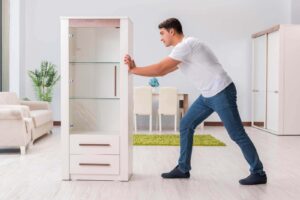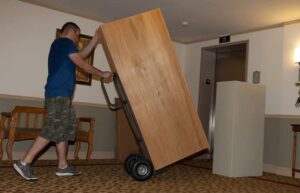How to Move a Dresser by Yourself: Easy DIY Tips & Tricks
Get Your Free Moving Estimate
Moving a dresser alone might seem tough, but it’s doable with the right steps. First, you need a solid plan and the right tools. It’s crucial to prepare well to avoid damage or injury.
Start by checking your space and the dresser. This helps you figure out the best way to move it. Whether you’re moving to a new place or just rearranging, knowing how to do it alone is key. With the right tips, moving a dresser by yourself is easy. Soon, you’ll have your space set up just the way you like it.

Essential Safety Precautions Before Moving Your Dresser
When moving a dresser, safety is paramount. Proper precautions can prevent injuries and damage. It’s important to know if you can handle the dresser’s weight and size.
Before moving, check your physical strength and the dresser’s weight. This helps decide if you need help or special tools. Look out for slippery floors, tight spots, and fragile items that could get damaged.
Assessing Your Physical Capabilities
Be honest about your physical abilities. Think about your strength, endurance, and any physical limits. This helps you decide if you need help or special tools for a safer move.
Understanding Weight Limits
Knowing the dresser’s weight and the path’s capacity is crucial. Make sure you know the dresser’s weight and the tools’ limits. This avoids overloading and reduces accident risks.
Identifying Potential Hazards
Spotting hazards is vital for a safe move. Look at your path for slippery floors, tight corners, and fragile items. These precautions lower injury and damage risks.
Required Tools and Materials for Moving a Dresser Solo
Having the right tools and materials is key when moving a dresser alone. You need to be well-prepared with the necessary equipment for a successful move. Essential tools include furniture sliders, a dolly, straps, and padding for your floors and walls.
A furniture moving kit is a great investment. These kits have straps, sliders, and other tools. They help you move through tight spaces and protect your belongings. Here are some must-have tools and materials:
- Furniture sliders
- Dolly
- Straps
- Protective padding for floors and walls
- Furniture moving kit
Using the right tools can prevent damage to your floors and walls. It also helps avoid injuries. Quality moving equipment ensures a safe and successful solo move.
Preparing Your Dresser for the Move
When moving your dresser, it’s key to prepare it well. Start by emptying and cleaning it. This makes it lighter and keeps things from moving around. It also lets you dust and vacuum, getting rid of dirt.
Securing drawers is also important. You can use tape or rope to keep them shut. Or, you can take them out and pack them separately. This stops drawers from opening or falling off, protecting your dresser and its stuff.
Protecting Your Dresser
To keep your dresser safe, use padding or bubble wrap. This stops scratches and dings. You can also use covers or blankets to keep it clean from dust and debris. These steps help your dresser stay in good shape during the move.
Additional Tips
- Use strong packing materials like boxes and paper to protect your dresser’s stuff.
- Make sure to label each box and drawer clearly. This makes it easy to know what’s inside.
- Take apart any parts you can, like handles or shelves. This helps prevent damage during the move and a packing service can assist in disassembling and properly packing these parts.
By following these tips, you can make sure your dresser moves safely and successfully. Remember to secure drawers and protect the dresser’s surfaces and corners. This makes the move easier and keeps your dresser safe.
How to Move a Dresser by Yourself: Step-by-Step Guide
Moving a dresser alone needs careful planning to avoid back strain or injury. It’s crucial to use the right lifting method and tools. Always consider the dresser’s weight and size before moving.
To lift correctly, bend at the knees, keep the dresser close, and lift with your legs. This method spreads the weight and lessens back strain. Using dollies and sliders also helps by reducing friction and effort.
Proper Lifting Technique
- Bend at the knees to lower your center of gravity
- Keep the dresser close to your body to maintain balance
- Lift with your leg muscles to avoid straining your back
Using Moving Equipment Effectively
Tools like dollies and sliders make moving a dresser easier. They cut down on friction and effort, helping you move through tight spots.

Navigating Tight Spaces
In tight spaces, move slowly and think about taking apart the dresser. Use straps to keep it on a dolly for better control. By following these steps and using the right tools, you can move a dresser by yourself safely.
Best Moving Equipment for Solo Dresser Transport
When you’re moving a dresser alone, the right tools are key. The best moving equipment makes your move safer, easier, and less likely to damage things. For moving a dresser by yourself, you’ll need furniture dollies, sliders, and straps.
These tools help a lot during a move. A furniture dolly supports heavy things and has wheels for easy moving. Sliders go under the dresser’s legs to cut down on floor friction. Straps keep the dresser on the dolly or hold drawers in place.
Using the best moving equipment for solo dresser transport has many benefits. For example:
- It reduces the risk of injury from lifting heavy things.
- It causes less damage to floors and walls.
- It makes moving through tight spaces easier.
- It speeds up the moving process.
Reviews and recommendations all agree: high-quality moving equipment is essential. With the right tools, your solo dresser move will be stress-free and safe.
Navigating Stairs and Doorways When Moving Alone
Moving a dresser by yourself can be tough, especially stairs and doorways. It’s key to have a plan. You might need to remove drawers, use straps, and move slowly.
Before you start, check if the dresser fits. Measure it against the doorway or stairs. Also, think about how you’ll approach the doorway. Sliders can help with this.
Staircase Strategy
Going up stairs with a dresser needs patience and care. Clear the stairs first. If you can, get someone to help you.
If you’re alone, use straps to keep the dresser steady. Move slowly and carefully on each step.
Doorway Maneuvering Tips
Doorways need careful planning. Measure the dresser and doorway before you start. Sliders can make it easier.
Handling Tight Corners
Tight corners need patience and sometimes a bit of creativity. You might need to tilt or turn the dresser. This helps avoid damage.
Take your time and don’t hesitate to ask for help if needed.
Preventing Damage to Floors and Walls
When you move a dresser by yourself, think about the damage it could cause. Protecting your floors and walls is key to avoiding expensive repairs. Use materials like cardboard, blankets, or floor and wall protectors to help.
Place these materials on the floors and walls along your path. Also, cover the dresser’s surfaces that might damage things. This way, you protect both the dresser and the surfaces around it. Here are some ways to protect floors and walls:
- Use felt pads or furniture sliders to reduce friction and prevent scratching
- Put cardboard or blankets on the floor to protect against heavy furniture
- Secure any loose items or hardware on the dresser to prevent damage
Protecting your floors and walls is crucial for a safe move. Always remember to prioritize protection. This way, you keep your home looking great and intact.
Post-Move Dresser Care and Placement
After moving your dresser, it’s key to take care of it. Check for damage like scratches or broken parts. Fix these problems right away. Also, where you place your dresser matters a lot. It affects how the room looks and works.
There are a few things you can do to keep your dresser in top shape. These include:
- Inspecting the dresser for damage and addressing any issues
- Repositioning and leveling the dresser to ensure stability and evenness
- Restoring the contents of the dresser in an organized and clutter-free manner

By following these steps, you can make your dresser last longer. It will stay useful and look good in your home. Where you put your dresser is also important. It should fit well with other furniture and the door. This makes the room look better and work better.
By taking good care of your dresser and placing it right, it will stay beautiful and useful for many years. Always be gentle with your dresser. If you’re not sure about anything, get help from a professional.
Conclusion: Successfully Moving Your Dresser Solo
With the right techniques and equipment, moving a dresser by yourself is doable. Follow the steps in this guide to move your dresser without help. Always prioritize safety, use proper lifting, and use moving aids to make it easier.
Whether you’re rearranging your home or moving to a new place, moving your dresser alone is a big win. Use what you learned here to tackle future furniture moves with ease. And if you need help, Mustang Moving is always available to make your move smoother and stress-free.
Be brave, stay focused, and ask for help if you need it. With the right attitude and planning, moving a dresser alone is possible. Good luck with your move!
FAQ
What safety precautions should I take before moving a dresser by myself?
Before you move a dresser, check if you can handle it. Know the dresser’s weight and look out for dangers. Wear safety gear, lift right, and plan the dresser’s path for a safe move.
What tools and materials do I need to move a dresser solo?
You’ll need furniture sliders, a dolly, straps, and padding for floors and walls. For bigger dressers, a moving kit might be needed.
How do I properly prepare my dresser for the move?
First, empty and clean the dresser to make it lighter. Secure drawers and hardware. Then, pad the surfaces and corners to protect them.
What is the proper technique for lifting and moving a dresser by myself?
When lifting, bend at the knees and keep the dresser close. Lift with your legs. Use dollies and sliders to make moving easier. Move slowly in tight spots.
What is the best moving equipment for solo dresser transport?
The top gear for moving a dresser alone is dollies, sliders, and straps. Dollies handle heavy loads, sliders reduce floor friction, and straps keep things secure.
How can I navigate stairs and doorways when moving a dresser by myself?
For stairs, remove drawers and use straps to secure the dresser. Measure doorways and use sliders to fit through. Approach at the right angle for easier movement.
How can I prevent damage to my floors and walls during the move?
Use cardboard, blankets, or protectors along the path and on the dresser. Wrap or pad the dresser to protect your home.
What should I do after successfully moving the dresser to its new location?
After moving, check the dresser for damage. Level and reposition it. Put back the contents carefully. This keeps the dresser in good shape for its new spot.
